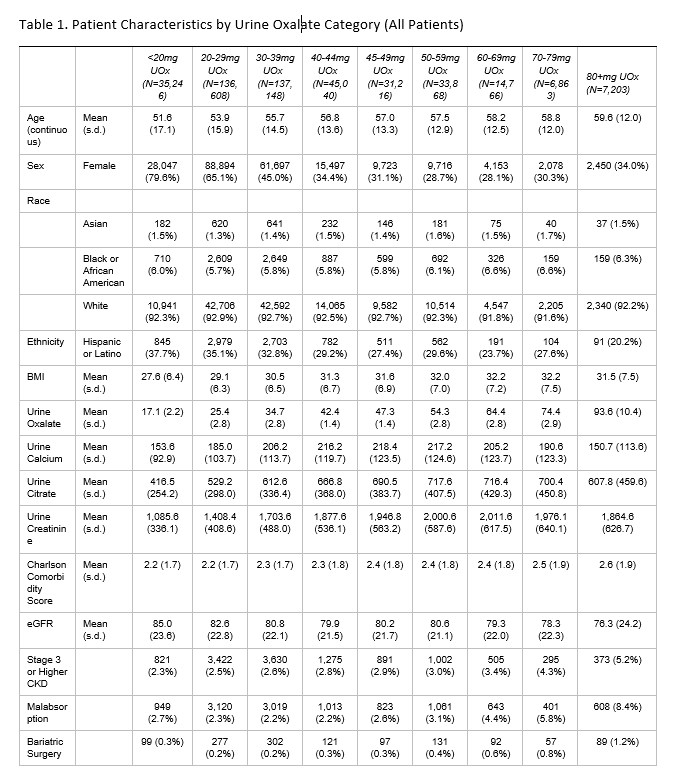Back
Poster, Podium & Video Sessions
Moderated Poster
MP26: Stone Disease: Epidemiology & Evaluation I
MP26-05: Characteristics of patients with and without malabsorption according to 24-hour urine oxalate excretion
Saturday, May 14, 2022
10:30 AM – 11:45 AM
Location: Room 225
Kyle Wood*, Birmingham, AL, Marja Puurunen, Kyra Mulder, Cambridge, MA, James MacDougall, Haverhill, MA, Caroline Kurtz, Aoife Brennan, Gary Curhan, Cambridge, MA
- KW
Kyle D. Wood, MD
University of Alabama at Birmingham
Poster Presenter(s)
Introduction: Hyperoxaluria may result from intake of high oxalate foods or enhanced intestinal absorption of dietary oxalate caused by gastrointestinal disorders with underlying malabsorption, including Crohn’s disease, short bowel syndrome, gastric bypass surgery, and chronic pancreatitis. Hyperoxaluria has been associated with negative outcomes, including kidney stones and chronic kidney disease. A greater understanding of the characteristics of patients according to 24-hr urine oxalate (UOx) excretion in a large population is needed.
Methods: This is a retrospective observational cohort study of patients in the US who have completed at least one 24-hr urine collection analyzed by a central laboratory during the study period of 1/2013 through 12/2020. Patient data were drawn from a multi-source data cloud containing deterministically linked, de-identified, individual-level healthcare claims and electronic medical records data. Malabsorption was defined by the presence of a relevant ICD 9/10 or CPT code.
Results: 447,958 individuals age = 18 years had at least one 24-hr urine collection and at least 6 months of baseline data. Of these, N=12,522 (2.8%) had an underlying malabsorptive condition (MC) preceding the index urine. Characteristics for the overall population by oxalate category are shown in the Table and results for patients with MC are reported. The proportion with UOx >= 40 mg/d was 30% overall and 39% in those with MC. Patients with higher UOx were older, less likely to be female and Hispanic, and had lower eGFR; had higher BMI, urine creatinine, and Charlson Comorbidity score; and were more likely to have CKD. Urine calcium rose then fell resulting in an inverted “U” shape across UOx categories. Among patients with MC, similar patterns were seen though in the highest oxalate category, urine calcium was even lower (101.4 mg) and the proportion with CKD was even higher (10.9%).
Conclusions: Patient characteristics differ substantially across 24-hr urine oxalate categories, and some clinically important characteristics of patients with a malabsorptive condition and high urine oxalate are even more extreme.
Source of Funding: Synlogic Inc.

Methods: This is a retrospective observational cohort study of patients in the US who have completed at least one 24-hr urine collection analyzed by a central laboratory during the study period of 1/2013 through 12/2020. Patient data were drawn from a multi-source data cloud containing deterministically linked, de-identified, individual-level healthcare claims and electronic medical records data. Malabsorption was defined by the presence of a relevant ICD 9/10 or CPT code.
Results: 447,958 individuals age = 18 years had at least one 24-hr urine collection and at least 6 months of baseline data. Of these, N=12,522 (2.8%) had an underlying malabsorptive condition (MC) preceding the index urine. Characteristics for the overall population by oxalate category are shown in the Table and results for patients with MC are reported. The proportion with UOx >= 40 mg/d was 30% overall and 39% in those with MC. Patients with higher UOx were older, less likely to be female and Hispanic, and had lower eGFR; had higher BMI, urine creatinine, and Charlson Comorbidity score; and were more likely to have CKD. Urine calcium rose then fell resulting in an inverted “U” shape across UOx categories. Among patients with MC, similar patterns were seen though in the highest oxalate category, urine calcium was even lower (101.4 mg) and the proportion with CKD was even higher (10.9%).
Conclusions: Patient characteristics differ substantially across 24-hr urine oxalate categories, and some clinically important characteristics of patients with a malabsorptive condition and high urine oxalate are even more extreme.
Source of Funding: Synlogic Inc.

.jpg)
.jpg)